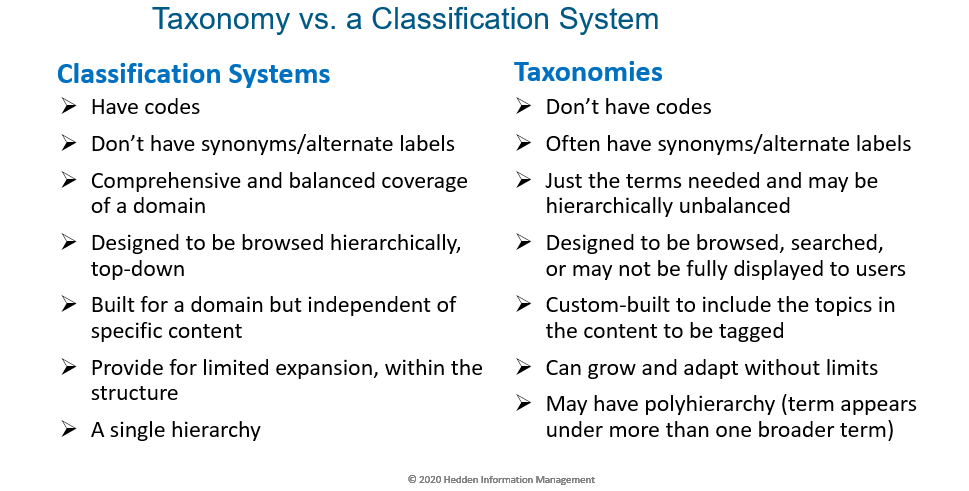Is a taxonomy the same as a classification scheme or system? Or, to put it another way, is a classification system, such as the Dewey Decimal System, a kind of taxonomy? Both of these kinds of knowledge organization systems have the feature of arranging terms in a hierarchy of multiple levels, without having related-term relationships or necessarily synonyms/nonpreferred terms, which are features of thesauri. So, it appears as if the only difference is that classification systems have some kind of notation or alphanumeric code associated with each term, and taxonomies do not. The differences, however, are greater than that.

Classification systems
The codes/notations in classifications are not merely shortcut conveniences. They represent a way to divide up the area of knowledge into broad classes, sub-classes, sub-sub-classes, etc. The codes/notations are not an after-thought but are planned from the beginning of the design of a classification system.
The classification is comprehensive; everything in the subject domain is covered with a classification code + label. There is often not a lot of room for expansion, except for a few unused sub-unit codes in each area for new topics. The word classification means to put into a predefined class or grouping. The approach to classification is thinking “where does this go?” (Digital documents may go into more than one classification.)
Classification systems are not just used in libraries, but in corporate settings too, such as for research literature or detailed manufacturing product catalogs. The standard for defining knowledge organization systems for interoperability on the web, the Simple Knowledge Organization System (SKOS), developed by the World Wide Web Consortium (W3C), recognizes classifications systems, by having a designated element for “notation.”
Taxonomies
A taxonomy is a kind of knowledge organization system that has its terms hierarchically related to each other. The starting point in creating a taxonomy might be a few top terms or facets, but then the focus of taxonomy development is on the specific terms needed, rather than the division of a domain into classes and subclasses, etc. What this means is that the terms do not have to comprehensively cover the subject domain in an abstract manner. Rather the terms have to “cover” the topics appearing in the body of content to be tagged with the taxonomy.
The taxonomy is used for tagging or indexing, not for classification or cataloging. So, rather than thinking where (into what class) does this document go, the question is, what is/are the main topic(s) of this document. The topics might not fall into neat balanced hierarchies. For example, an intranet taxonomy might have a term for Temporary employees, because there are some human resources policies dealing with this topic specifically, but have no term for Full-time employees, since that is the default, and the term would not be useful (and likely inconsistently tagged).

Different mindsets
Lumpers and splitters are historically two opposing viewpoints in categorization and classification: whether you “lump” items into large categories, focusing on the similarities, or “split” items into more smaller categories, focusing on the differences. Of course, there is often a combination of both approaches, but it is my feeling that the design of modern taxonomies tends to involve more lumping, whereas the design of classification systems has involved more splitting.
One of the challenges of working with subject matter experts (SMEs) in building a taxonomy is that SMEs, as experts in their domain, may tend to think of how to classify their domain, and propose a taxonomy that resembles a classification system, even if it lacks the codes/notations. So, it’s very important to provide precise guidelines to SMEs contributing to a taxonomy, explaining that the terms are intended for tagging common topics that appear in the content and are for limiting/filtering search results, and that full classification is not necessary.
Students of library science may also tend to think of classification systems as serving for taxonomies. They learn about classification systems when they study cataloging, and subject cataloging is also about where the book or other library material belongs (often literally, on the shelf). So, even librarians need training on taxonomies and the taxonomy mindset if they want to become taxonomists. I will be addressing students at Simmons University School of Library and Information Science in a panel discussion organized by the New England Chapter of the Special Libraries Association (SLA) this month, and I will be giving a taxonomy workshop at the Computers in Libraries conference next month, so I will be sharing these ideas with those who attend.
